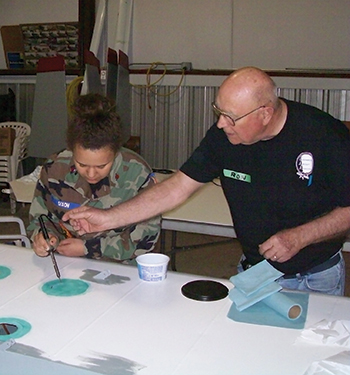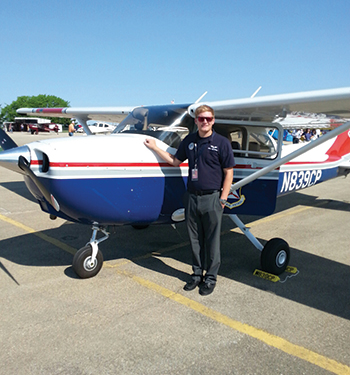An overview of Civil Air Patrol, the official civilian auxiliary of the U.S. Air Force
Since 1946, Civil Air Patrol (CAP) has served as the official auxiliary of the United States Air Force, charging its members with three missions. First, it promotes the benefits of general aviation and aerospace education, both internally to members and externally to the general public. Second, it provides a cadet training program to support youth in contributing to society and preparing for success as adults. Finally, it provides emergency services and disaster relief, the work for which it is often known today. Chartered by Congress as a nonprofit corporation, it maintains the largest privately-owned aircraft fleet in the world.
A Pocket History
In the 1930s, aviation enthusiast Gill Robb Wilson conceived the idea of the Civil Air Patrol (CAP) to supplement America’s military air forces. On December 1, 1941, New York Mayor Fiorello H. LaGuardia, then-head of the new Office of Civilian Defense, created the Civil Air Patrol through Administrative Order 9. The day before it was published, however, the Japanese Navy attacked numerous United States naval bases; the first, and most important, was Pearl Harbor in Hawaii. Four days later, on December 11th, Germany, Japan’s ally, declared war on the United States.
Hitler’s declaration from the Reichstag set into motion Vizeadmiral Karl Dönitz, who implemented a plan called Unternehmen Paukenschlag (Operation Drumbeat). Dönitz was commander of the Kriegsmarine’s U-boat arm (Ubootwaffe), who briefly became Reichspräsident—from April 30, 1945 to May 23, 1945—succeeding Hitler as head of state. Until then, the Third Reich’s U-boats had only been observing the U.S. coast—following convoys and keeping track of traffic. They were under orders not to attack. With Operation Drumbeat, however, the U-boats were now on a war footing. They began menacing our coastal waters, sinking convoy ships that were transporting supplies to Europe.
A decision was made to utilize the Civil Air Patrol for patrols and U-boat spotting, as well as warfare. These civilian planes directed the U.S. Navy to the German U-boats, dove at them in mock strafing runs, and forced submarines to break off their attacks, dropping 83 bombs and depth charges. They located 173 U-boats, attacked 57 of them, struck 10 and sank two. CAP pilots flew more than 24 million miles during the war, and 64 members died in combat.
After the war, the 113th Congress passed S.309, a bill that awarded the Congressional Gold Medal to CAP veterans. During one post-war interrogation, one U-boat commander was asked why the German submarines backed off from the coast. “Because of those damn little red and yellow planes,” he replied, referring to the civilian aircraft of the Civil Air Patrol.
In 1947, the modern United States Air Force (USAF) was formed. Shortly thereafter, by congressional and presidential order, the Civil Air Patrol was chartered as the United States Air Force Auxiliary, Civil Air Patrol—an arm of the U.S. Air Force. The new charter stated that CAP would no longer be an armed combat unit; in the future, it would have a benevolent mission encompassing emergency services, aerospace education and cadet programs, as symbolized by the symbol of the three-bladed propeller. Since CAP’s incorporation, the Air Force has served it in a supervisory capacity, while CAP officers and cadets proudly wear USAF uniforms when performing their duties.
CAP Services
Emergency services grew out of the operational missions from World War Two, an area that includes Air Force support, search-and-rescue sorties, humanitarian missions and disaster relief. In fact, Civil Air Patrol is involved in more than three quarters of all USAF search-and-rescue missions in the country, searching for downed airplanes and directing ground crews to rescue areas. Cadets are trained in ground communications and radio direction finding (RDF), flying over storm-damaged areas to photograph and direct rescue crews. CAP pilots also assist the Air Force with combat rescue training exercises and are often called upon to fly training missions, during which the CAP fleet flies into restricted airspace and USAF pilots fly “intercept,” allowing them to practice high-speed intercepts of enemy aircraft.
Civil Air Patrol assists not only the USAF, but the U.S. Coast Guard and Coast Guard Auxiliary, as well as the Department of Homeland Security and law enforcement in the war on drug trafficking operations. Its pilots fly over 12,000 hours each year assisting agencies like the U.S. Customs and Border Protection, Drug Enforcement Administration and the Forest Service, utilizing special reconnaissance equipment to search for illicit crops. In addition, CAP assists civil organizations like the Red Cross and Salvation Army with humanitarian missions, transporting medical supplies and staff during disaster relief operations. CAP pilots also fly critically ill patients to treatment facilities.
Internally, CAP’s aerospace education program provides members with instruction in all aspects of aviation, including flight physics, dynamics, history and application, as well as the space program. CAP also has an external aerospace education program which conducts workshops through state educators and helps teachers integrate aerospace and aviation information into the classroom.
CAP’s cadet programs have been around since World War Two, instilling leadership qualities and training future pilots. Individuals as young as 12 can join and serve until they are 18, when they are transitioned into the senior/adult ranks. Cadets must complete certain aerospace education programs in order to progress through the levels of their programs. In addition to training to become FAA-licensed pilots, they have the opportunity to participate in military orientation rides, national programs and tours, like the one recently made by the Peoria Composite Squadron. On a visit to the Experimental Aircraft Association (EAA) hangar at Mt. Hawley Airport, EAA members Ron Wright and Greg LePine instructed the cadets on aircraft construction and restoration, as well as aerodynamics, assembly of materials, and the making of inspection holes in fabric-covered wings.
Based out of the 182nd Airlift Wing base at the General Wayne A. Downing Peoria International Airport, the Peoria Composite Squadron is commanded by Major Ted Deming. The oldest squadron in Illinois, it was founded six years after President Harry S. Truman created the modern Civil Air Patrol.
 Semper Vigilans
Semper Vigilans
There is a longstanding tradition—dating back to the founding of our country—of U.S. citizens standing shoulder to shoulder with our soldiers to defend our soil and way of life. Japan abandoned its invasion plans during World War Two, in part because they knew they would not only be fighting the U.S. military, but its civilians as well—like the volunteers of the Civil Air Patrol. It was a reality with which the German U-boat commanders certainly had to come to terms.
CAP’s motto is semper vigilans (“always vigilant”)—and we are. This is why the misguided, destructive actions of those who would attack us today are futile and will never succeed. iBi
Lt. David R. Anderson, Jr. is Squadron Historian for the U.S. Air Force Auxiliary, Civil Air Patrol, Peoria Composite Squadron. For more information, visit peoriasquadron.com.


